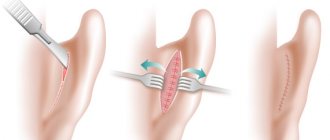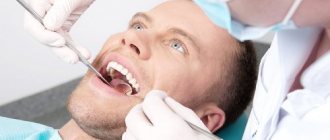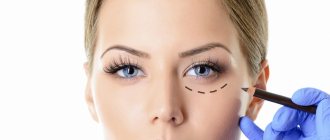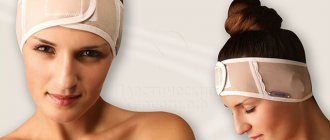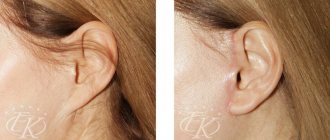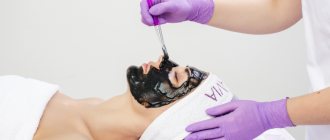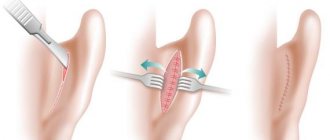Ear plastic surgery was a widespread operation even when no one knew anything about the wonders of modern plastic surgery in our country. An aesthetic defect that is too visible is protruding ears or asymmetry of the ears. Since this operation is generally uncomplicated, getting rid of the problem, as a rule, does not entail additional unpleasant experiences. Complications are rare, especially when it comes to earlobe plastic surgery. But nevertheless, they meet.
Who should not undergo otoplasty?
Let us remind you about contraindications:
- Cardiovascular system disorders
- Acute infectious diseases
- Allergic reactions
- Previous oncological diseases
- Skin diseases with manifestations in the area of the proposed intervention
- Severe endocrine disorders
The doctor can be stopped by other factors. For example, even if your blood clotting is fine, but you are a woman and you are scheduled for surgery on the day of your menstruation, it is recommended to reschedule the procedure. Because these days the body is “tuned” to bleeding.
After otoplasty, the ears are tightly pressed to the head. Should I worry?
Don't rush to conclusions, this may be a temporary phenomenon. After six months you can judge the result. Recovery is a complex physiological process that does not occur as quickly as we would like. If, after otoplasty, the ears are pressed tightly against the head, this causes anxiety and discomfort, the procedure may be considered for a second time.
Asymmetry is an indication to operate again. Pathology occurs if the operation was performed on one ear. However, the appearance of a defect occurs when both organs are operated on. In this case, repeated surgery involves reconstructive correction.
If it is impossible to achieve an ideal result the first time, plastic surgery is carried out in two stages. The surgeon warns immediately about a repeat intervention.
It is difficult to understand the causes of the defect. You cannot determine on your own whether additional correction is needed or whether the problem will disappear after some time. A conversation with a doctor will help you decide whether a repeat procedure is advisable. You can sign up for a free consultation by calling the number listed on the website.
Complications after otoplasty
Complications after otoplasty occur infrequently. Many of them are associated with improper care of the ears in the postoperative period. However, not everything depends on the patient’s patience - there are moments that are completely individual for each organism. How exactly your recovery period after surgery will unfold can only be assumed in general terms.
The main complications after otoplasty include:
- Bleeding
- Hematomas
- Inflammatory process
- Epidermolysis and maceration of the epithelium
- Allergic reactions to compounds used to treat wounds
- Asymmetry and incomplete correction
- Keloid scars
- Perichondritis
Bleeding after surgery is completely normal. The same as small hematomas. Since any surgical intervention is an injury, you need to be patient and wait 7-10 days. As a rule, during this period all troubles stop. If the bleeding after the operation was severe, and there were additional aggravating circumstances (for example, you accidentally pulled off the fixing bandage in your sleep and injured your newly operated ear), then the direct route is back to the surgeon.
Hematomas on the front surface of the ear are more dangerous than on the outside. Firstly, they reduce the achieved aesthetic result (as a rule, they look like bluish or purple “bubbles” full of blood). And secondly, there is a risk of infection. Such hematomas are opened without fail.
The inflammatory process is difficult to miss, as it will be accompanied by pain, pulsation in the ear and increased body temperature. If any of the above is present, consult a doctor immediately. An infectious process in a wound is dangerous because it can lead to cartilage necrosis and the need for reoperation.
Epidermolysis and maceration of the epithelium will also not go unnoticed, since they have a characteristic appearance - the skin at the site of intervention peels off and blisters. In mild cases, special therapy is not required and goes away on its own within a few days.
Allergic reactions to drugs used to treat wounds. They are bad because they can cause significant discomfort, especially with skin manifestations - pain, itching. Symptoms are relieved after taking antihistamines.
Asymmetry and incomplete correction are a complication that can be assessed after your wounds have healed. This may be due to the individual characteristics of your tissues, or to the fact that you did not follow the doctor’s recommendations for care. Unfortunately, there are cases when the correction has to be repeated several times.
Hypercorrection is the other side of the coin. Ears that are pressed too tightly to the head can also create discomfort and look unnatural. In addition, in this case the shell itself may become deformed. The complication is rare - as a rule, a qualified doctor does not allow it.
Keloid scars . Mostly related to the individual characteristics of the patient’s body. Some people are predisposed to forming these tumor-like scars. In this case, you will have to operate on the place where the scar appeared.
Perichondritis is an inflammation of the membrane covering the ear cartilage. It occurs relatively rarely, but can be very dangerous, since in some cases it can lead to necrosis of cartilage tissue.
- Failed otoplasty.
- Bleeding and hematomas. Since during the operation the surgeon breaks and excises the cartilage tissue in your ears, bleeding and bruising in the postoperative period cannot be avoided. The problem is that hematomas do not go away for a long time, and most likely, within six months you will not be able to sleep on your side, and touching your ears will cause pain. For example, the excessive pressure that a hematoma exerts on the cartilage can lead to its necrosis.
- Wound infection. May develop around the operated area 3 or 4 days after ear otoplasty . It may seem insignificant (manifests itself as slight redness and slight soreness) - and this is its insidiousness. Advanced infection may require surgery.
- During rehabilitation after otoplasty Suture cutting and overcorrection may occur. Basically, both are associated with insufficient competence of the surgeon, incorrect selection of suture material, as well as insufficient preoperative diagnostics. The ears after such otoplasty do not look aesthetically pleasing, and such sutures require surgical removal.
- Warping of the ear cartilage.
The most unpleasant thing is if the ears become uneven after otoplasty. This is mainly noticeable at the site of the formed antihelix and occurs due to the fact that the surgeon did not apply the sutures close enough, and the ear cartilage sought to return to its original position.
Your ears may return to their original position.
Moreover, they can do this asymmetrically, which will make your appearance even more unattractive than if your ears were simply protruding. Another option may be a repeat operation, because... the ears may begin to return to their original position. This can happen for several reasons - the surgeon was not experienced enough, he used self-absorbing suture material, which did not hold the auricle in the desired position for a long enough time. Perhaps the patient himself removed the fixing bandage too early, which led to this result.
Of course, in this case, you will most likely have to have a second operation. And again, no one will give you a guarantee that this operation will be the last.
Unsuccessful otoplasty, the consequences of which were described in this article, is not common, but not such a rare occurrence. Those who decide to undergo otoplasty should remember all these consequences, and also that in many cases, even after removing the compression bandage and sutures, the surgeon will still advise you to wear ear correctors. They are recommended to be worn for about a year after ear otoplasty. They will serve as a good guarantee that your ears will fit snugly to your head, become symmetrical, and you will be happy with your new appearance.
How to avoid complications
The main recommendation is to carefully select a surgeon who specializes in just such operations. This will remove many risks on its own.
The second important point is the patient’s discipline after surgery. You will need to wear a special fixing bandage for two weeks, in which you will eat and even sleep. It is also not recommended to engage in strength sports and generally intense physical training, lift weights, or catch a cold during the recovery period. A weakened immune system can be detrimental to a postoperative wound. And training can even lead to divergence of the seams.
Remember : the doctor can do the most to make you happy with your ears. But it’s worth making some effort for you too!
Plastic surgery / Ear plastic surgery (Otoplasty)
| Section: Ear plastic surgery (Otoplasty) Articles: Ear shape - history and anthropology History of ear plastic surgery Development and anatomy of the external ear Ideal proportions of the ears Classification of protruding ears (protruding ears) | Indications and contraindications for surgery Preparation for otoplasty Ear surgery (otoplasty) After otoplasty Complications and risks of otoplasty Otoplasty: results (before and after photos) |
One of the complications of otoplasty is the discrepancy between the results of the operation and the patient’s expectations. But if the otoplasty operation is performed correctly, the patient is adequate, informed and has realistic expectations, he will almost always be satisfied.
In the first days after otoplasty, there may be a slight rise in temperature. If the temperature rises to high levels, severe swelling occurs, or intense pain appears in the wound area, you should immediately contact the clinic; this may be inflammation. Although inflammation rarely develops after otoplasty surgery, antibiotics are always prescribed as a preventive measure.
Cases of prolonged persistence of pain (neuralgia) in the area of a postoperative scar have been described; this occurs extremely rarely. As a rule, the pain goes away within a year with drug treatment, otherwise corrective surgery is performed.
Another complication of otoplasty may be bleeding and, as a result, the appearance of a hematoma. For this reason, the otoplasty patient is advised to maintain close contact with the operating surgeon immediately after surgery. If bleeding does occur, it is usually easy to stop; to do this, an incision is opened, the small amount of blood that has accumulated under the skin is removed, and those small vessels that are bleeding are cauterized. Postoperative bleeding does not have a negative impact on the outcome of otoplasty. The risk of bleeding after otoplasty is greater if the patient was or is taking aspirin or other anti-inflammatory medications before surgery. For the same reason, otoplasty surgery cannot be performed on girls during menstruation, since the blood coagulation system is predisposed to bleeding during this period. If a blood clot has formed somewhere under the skin that is too small to be noticed and removed, then after the swelling has subsided, a slight swelling may remain in that area. It will disappear over time, but this may take weeks.
Early rehabilitation period: dressings, sutures, bandage
Lasts only 14 days. Usually, 2-3 hours after otoplasty, the patient can go home. Then within 2-3 days you need to come to the clinic to treat postoperative wounds and dressings. Gauze swabs soaked in antiseptics and healing ointments are applied to the suture area. To relieve pain, the specialist prescribes painkillers and anti-inflammatory drugs to reduce swelling.
A week after the plastic surgery, the sutures are removed. To prevent bleeding, purulent inflammation and accelerate tissue regeneration, we recommend to our patients:
- do not wash your hair until the stitches are removed; after that, use baby shampoos throughout the entire recovery period, as they irritate the skin less;
- sleep only on your back, so as not to accidentally touch the auricle during your sleep and provoke tissue displacement;
- choose a high pillow: resting in this position will help reduce swelling;
- stop wearing glasses;
- exclude physical activity.
Bandage after otoplasty
A circular, elastic or compression bandage is applied on top of the aseptic gauze bandage. Outwardly, it resembles the headband worn by tennis players. It is flesh-colored and, if necessary, can be hidden almost imperceptibly under hair. Such a bandage protects the ear from damage and contamination, helps reduce swelling and bruises, but most importantly, it forces the auricle to take the correct anatomical position.
The compression bandage after otoplasty is worn continuously for the first 7 days. Starting from the second week of rehabilitation, you may not wear it during the day, but you must sleep in it. You can stop wearing it completely only on the recommendation of a doctor.
Progress of the operation
There are several techniques for performing otoplasty. They can be divided into three groups.
The first group of operations (suture) to correct the auricle uses sutures on the cartilage.
The second group of operations (resection) involves removing sections of cartilage and then stitching them together.
The third group is a combination of suture and resection techniques.
The choice of surgical technique to correct protruding ears depends on the correct preoperative analysis.
Auricular plastic surgery is performed on an outpatient basis and does not require hospitalization. The operation is performed under local anesthesia and usually lasts about an hour, sometimes a little longer.
The surgical field is treated and covered with sterile surgical linen. A skin incision up to 4 cm long is made behind the auricle. After hemostasis, the cartilage is modeled with incisions and sutures.
Sutures are applied with non-absorbable threads in such a way as to form the correct shape of the auricle and get rid of protruding ears.
The skin incision behind the ear is often sutured with threads that dissolve on their own.
Otoplasty: pain after surgery
When preparing the patient for discharge, an injection of pain medication is given - this is standard practice. For home care, the surgeon prescribes analgesics that easily relieve moderate pain. If its intensity increases sharply, is accompanied by bleeding, discharge of pus, an increase in the size of the ears, or high fever, you should contact your doctor.
In rare cases, the individual reaction of the body is such that even 2 weeks after otoplasty, pain after the operation persists. In the absence of complications, violations of the rehabilitation regime, or doctor errors, this is a variant of the norm.


